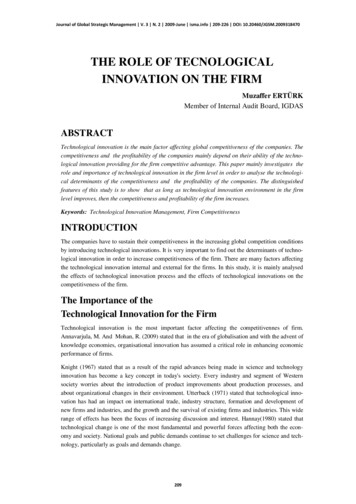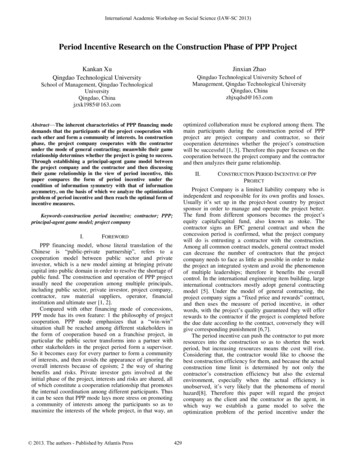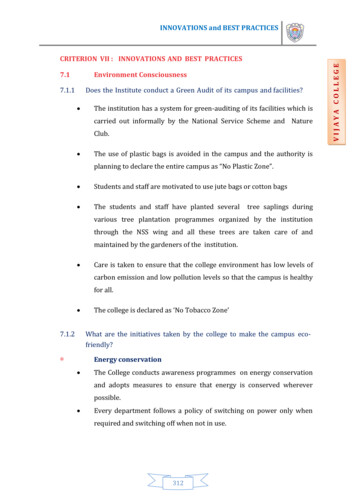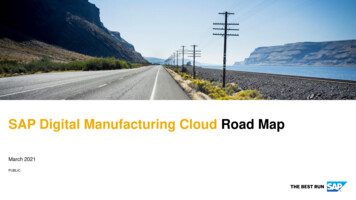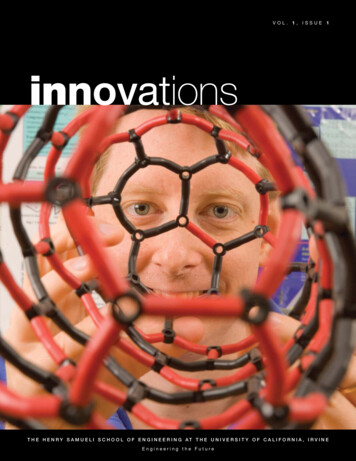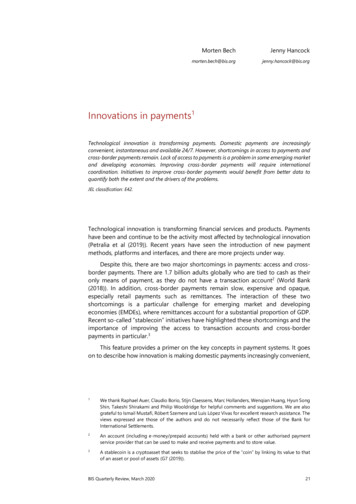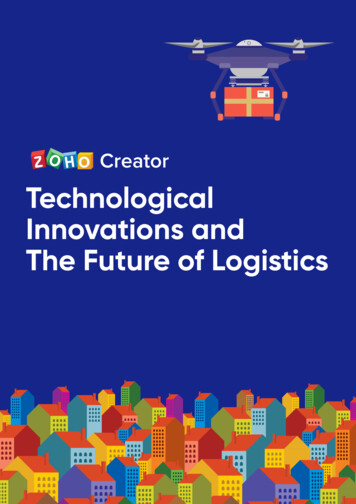
Transcription
TechnologicalInnovations andThe Future of Logistics
From horse-drawn carts to cargo aircraft,logistics has come a long way over theyears.With change being the only constant, the logistics industry can nolonger afford to prolong the status quo. New technological advancements are poised to transform logistics, disrupting it like neverbefore.Here’s a look at some crucial technologies that will impact the industry—an industry which has the potential to contribute 4 trillion to theglobal rtunity-5e824608bb7c2
Drones3
Drones, or unmanned aerial vehicles (UAVs), are flying robots that canbe remotely controlled by a person or a computer.Drones demonstrate a high potential for use in the logistics industry.The drone-based logistics market is expected to grow by an annualrate of 20%, with a valuation of 29 billion by 2027.2Amazon is currently attempting to provide under-30-minute deliveriesusing drones.3 It’s called Prime Air and is the first major example of howdrones can drastically improve customer satisfaction from a logisticsperspective. Drones can allow customers to receive their orders withoutthe need for human intervention.In Ghana, the largest drone delivery network on the planet4 has beenlaunched, delivering critical life-saving medical supplies and serving12 million s://www.amazon.com/Amazon-Prime-Air/b?ie UTF8&node ram-in-ghana/4
Drones can not only assist in deliveries, but they will also be used to: Move items in the warehouse and assist in palletization Keep track of item quantities using optical scanners and deeplearning technologies Supervise the warehouse and its workers Prevent inventory mismatches5
The Internetof Things6
The Internet of Things (IoT) is a network of physical objects—vehicles,machines, home appliances, and more—that use sensors and APIs toconnect and exchange data over the internet.IoT heralds the next generation of the internetGartner predicts5 that 5.8 billion automotive and IoT endpoints willbe in use in 2020, and 20.4 billion smart devices will be connectedthat same year.And because the possibilities of IoT are many, it opens up myriadopportunities for logistics:Logistics routingAccording to Forbes,6 Union Pacific, the largest railroad in the United States, uses IoT in its operations. This IoT system uses a networkof acoustic and visual sensors on railroad tracks. Data generatedby this matrix of sensors is then used to predict equipment failures,and preemptively avoid 2880f7
In logistics routing, IoT provide: Real-time tracking of the fleet by integration with telematics devices Enhanced safety Live traffic projectionImproved inventory managementInventory management is a crucial factor in logistics, and a herculean task to manage optimally. IoT, however, will make it a walk inthe park.7 RFID tags can be attached to items, ensuring a constantfeedback loop on the vital statistics of each one. Managers will beable to access data about stock status, expiration dates, item location, demand forecasts, and more.Streamlined warehouse operationsIoT sensors can provide data about the ambient conditions ofwarehouses, which will be of great use in the storage of perishable stock. The temperature can be set up to dynamically adjustitself, to extend the shelf life of these types of commodities.And IoT sensors can also be used to monitor energy consumption,leading to more economical power ings-inventory-management/8
Enhanced productivity and efficiencyIoT provides logistics organizations with enhanced productivityand efficiency, made possible by its ability to facilitate seamless multiplatform collaboration. IoT-enabled software providesreal-time access to the fleet and its workforce. This enablesleaders to make quick decisions and reduce operational overhead.9
ArtificialIntelligence10
Artificial intelligence (AI) is the simulation of human intelligenceprocesses, such as visual perception, speech recognition, anddecision-making by machines, especially computer systems.Recent research8 predicts that the implementation of artificialintelligence in the supply chain will allow companies to savebetween 1.3 trillion and 2 trillion per year worldwide.Let’s take a look at how AI can impact logistics:Autonomous vehiclesForklifts were the first vehicles to manage this feat. Powered byAI, they become machine-vision guided, completely autonomousmobile robots, gaining the ability to process orders four times faster than humans. Warehouses especially benefit from autonomousforklifts, as human movement is among the most unproductiveand time-consuming tasks in these situations.Trucks, vans, and buses can also be fully autonomous, or havepartial autonomy with a human driver present. Driverless vehicleswill reduce accidents caused by human error and lower the burden of physical labor, and in turn reduce expenses for ughout-thesupply-chain?FEATURE ARTICLES V1 011
Waymo, a pioneer in the autonomous vehicle domain, is tryingto build driverless trucks. It also seeks to make trucking safer,and their revenue is predicted to hit 114 billion by 2030.9Warehouse automationAI-powered robots can assist in warehouse automation tasks such as: Automatically sorting items - Items can be automatically sortedusing parameters such as weight and dimensions. Assessing the condition of items - Using optical image recognitionalgorithms, the condition of items like groceries can be assessed.Ocado is an automated warehouse pioneer.10 Ocado’s robotscan process 3.5 million items—lifting, moving, and sorting them forapproximately 65,000 orders every week. This AI-powered automation greatly reduces the human effort involved in managing the warehouse’s on 12
Streamlined operationsLogistics office operations are repetitive, so AI really comes to therescue here by offering several optimizations: Chatbots are AI-powered software solutions that can automaticallyrespond to customer queries. They eliminate the need to hireexpensive customer support associates. Business process automation software automates repetitive tasksand workflows, which allows stakeholders to devote attentionto what’s important. Also, this automation provides a higher returnon investment and cost savings.Improved customer experienceAmazon’s AI-powered assistant is tied up with DHL’s parcel service.11Using voice commands, users can track the status of their packagesby asking simple questions like, “Hey Alexa, where’s my package?”In response, Alexa will provide the shipment’s details. At its core,artificial intelligence-powered technologies like this will enhancethe customer /parcel/dhl-parcel-offers-alexa-interaction/13
Big DataAnalytics14
Big data12 refers to huge data sets that can be computationallyanalyzed to unearth patterns and trends. The use of softwarein the logistics industry generates lots of data, which can beanalyzed by data scientists to gain insight into improvingefficiency.In this 3PL study,13 98% of 3PL providers said that data-drivendecision-making is “essential to the future success of supplychain activities and processes.”Data can be gathered for analysis from these sources, among manyothers: Data from telematics devices which provide details on vehicles,routes, and location Financial data from audits and forecasts Traffic and weather data from sensors and satellitesSome of the advantages reaped from big data for logistics s-big-data.html13http://www.3plstudy.com/15
Optimized routingIn logistics, optimal routing is of the utmost importance. Withever-changing factors, such as the weather and traffic, a delayedfleet equals reduced profits. Data gathered from weather sensors,GPS, mobile devices, and telematics devices can be analyzed usingpredictive modeling to figure out the optimal route for delivery, allin real time. This will reduce delays in shipments and increase fleetefficiency.Crowdsourced last-mile deliveryLast-mile delivery can incur substantial overhead if not executedproperly. Using data gathered from applications running oncommuters’ mobile devices, deliveries that are heading in the samedirection can be identified. At that point, commuters can be paid tomake these deliveries. This eliminates the need for logistics playersto take care of the last-mile delivery in-house, reducing costs, andsimultaneously helping to reduce traffic.16
Market intelligence for businessesData scientists can analyze swathes of legacy shipment data, useregression analysis, and generate insightful reports which can assistthem in improving the precision of demand and supply forecasts.This intelligence is of great use to small and medium-sizedbusinesses seeking to maximize their operational revenues.17
LogisticsApplicationsof the Future18
Considering the impending upheaval in the logistics industry,organizations should adopt a digital transformation strategy inorder to stay ahead of the pack. This strategy should also determinethe most suitable software on which the business runs.When it comes to logistics software, ERPs are expensive and clunky,and generic logistics software won’t address all of your needs. Whatyou need is custom software to run your logistics business.14 Customsoftware development platforms like Zoho Creator15 enable you todevelop software all by yourself, with no prior computer programmingknowledge required. The logistics applications of the future arecustom applications.Zoho Creator is future-ready and can be used to harness anytechnological advancement the logistics industry may www.zoho.com/creator/19
LookingAhead20
What we've seen is just a glimpse of what the future has in storefor logistics.These technological innovations mean: Efficient operations Increased profits Radical growth Improved customer satisfactionTechnological advancements will take center stage in this new eraof logistics, shaping its future. Embracing these advancements willprovide tremendous benefits—it’s the solution to satisfying today’sever-increasing customer expectations.21
www.zoho.com/creatorWe’d love to talk! Reach out to us:sales@zohocreator.com22
Improved customer satisfaction Technological advancements will take center stage in this new era of logistics, shaping its future. Embracing these advancements will provide tremendous benefits—it’s the solution to satisfying today’



